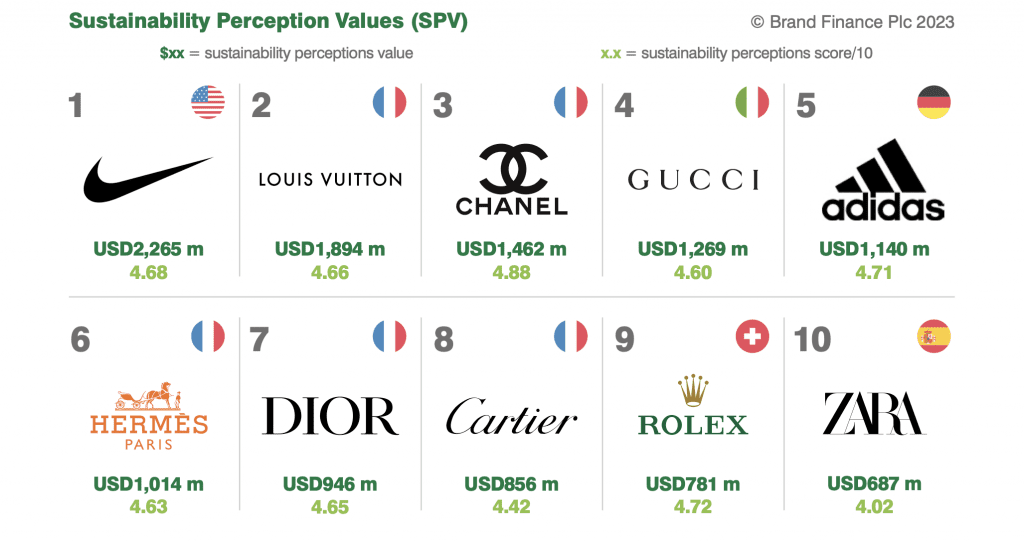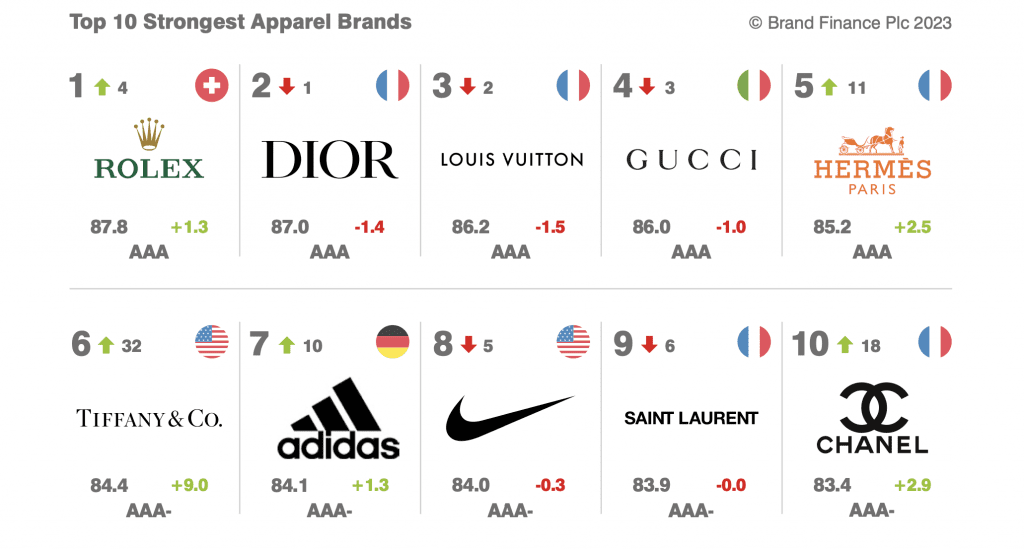Certain companies’ sustainability-specific marketing messaging is taking a toll on – or in some cases, bolstering – their brand value. That is what Brand Finance asserted in its latest apparel report. In addition to quantifying and ranking the intangible assets of global consumer goods companies (Nike took the top spot, followed by Louis Vuitton, Chanel. Gucci, adidas, Hermès, Dior, Cartier, Zara, and Rolex), the London-based brand valuation consultancy shed light on the increasingly sizable role of companies’ activities in the realm of sustainability and how their efforts to craft sustainability and broader ESG messaging is impacting the value of their brands – from fast fashion giants to luxury goods titans.
Fast Fashion – Looking first at fast fashion companies, Brand Finance states that not only has “global inflation and economic uncertainty disrupt[ed] the fast-fashion industry in the post-pandemic era,” but as sustainability “becomes an increasing driver of choice behind apparel brands, global fast-fashion companies are taking a hit to their brand strengths and reputations.” Specifically, H&M (brand value down 26 percent to $9.4 billion) and Zara (brand value down 15 percent to $11.0 billion) “have attempted to appeal to a growing consumer concern for sustainability by positioning themselves as environmentally conscious.”
However, Brand Finance asserts that “their weaker brand strength can be attributed to vague communication and a lack of transparency regarding sustainability.” For example, it notes that “H&M’s Conscious Collection” – which has been the subject of more than one false advertising lawsuit – “was found to extensively use synthetic materials derived from fossil fuels,” which “reflects a larger trend in the industry, whereby such retailers engage in ‘greenwashing’ to mask cost-saving initiatives.”

Going forward, “honest and transparent communication is integral for these brands to avoid greenwashing, rebuild consumer loyalty and resurge their brand strength and global reputations in the coming years,” per Brand Finance.
Nike – As distinct from the brand messaging coming from the likes of H&M and Zara, among other fast fashion companies, Brand Finance states that Nike has fared well with regards to its sustainability endeavors. “Nike has the highest ‘Sustainability Perceptions Value’ at $2.3 billion,” according to Brand Finance, which cites Nike’s “Move to Zero” campaign is “driving ambitious sustainability goals for the future, as Nike “aims to increase the use of recyclable materials in its products and make significant strides in donating, refurbishing, or recycling 10 times more finished product waste by 2025.”
Nike’s position at the top of the Sustainability Perceptions Value ranking is not an assessment of its overall sustainability performance. Instead, Brand Finance says that it “indicates how much brand value Nike has tied up in sustainability perceptions.” (An interesting sidenote here is that Nike’s brand value seems to be unscathed by an ongoing lawsuit that accuses it of false advertising in connection with its sustainability marketing.)
A Chinese Company – In another mention on the sustainability marketing front, Brand Finance contends that Bosideng has “further enhanced its global reputation through innovation and sustainability initiatives, investing in sustainable fabric and product solutions.” The Chinese outerwear brand “aims to create products that both cater to modern lifestyle demands while also demonstrating the brand’s commitment to environmental responsibility,” Brand Finance states.
Luxury Goods Brands – Finally, sustainability-centric attributes are relevant for luxury goods companies, with French trio Dior (brand value up 46 percent to $13.2 billion), Louis Vuitton (brand value up 12 percent to $26.3 billion) and Chanel (brand value up 27 percent to $19.4 billion) have all increased their brand values after experiencing promising sales growth this past year.” In addition to boasting high scores when it comes to brand strength, Brand Finance found that “their commitment to creative evolution, product innovation, and sustainability has enabled them to retain consumer loyalty and uphold their iconic brand images in the post-pandemic world.” (Note: Brand Strength is an evaluation of a brand’s “marketing investment, stakeholder equity, business performance, corporate reputation,” etc.)

Finally, Brand Finance takes on a couple of key questions that center on brand purpose and the link between sustainability and what consumers view as a “cool” brand. In terms of whether brand purpose “delivers,” Brand Finance states that “argument rages among chief marketing officers and marketing gurus over this issue.” While the jury is out, Brand Finance says that its data “suggests that being seen to ‘care about the wider community’ does correlate somewhat with higher Consideration levels.” (Consideration refers to whether consumers would consider buying/using a certain brand’s goods/services.) As such, efforts on the ESG front are an asset particularly for local favorites such as Jio (India) or Bunnings (Australia).
At the same time, the consultancy states that brands like McDonald’s and Amazon “are liked and desired despite somewhat moderate reputations on sustainability and values.”
As for the link between sustainability and coolness, Brand Finance found that “in categories like apparel, tech and automotive, sustainability can make [a brand] cool,” but it is, of course, not the only way to captivate consumers. Porsche, for example, “wins relatively few plaudits for sustainability,” Brand Finance states. And yet, “its über-coolness is very apparent.” Similarly in the apparel category (especially footwear), “the correlation between coolness and sustainability is not especially high.” As sustainability and climate concerns, in particular, continue to become integral issues for consumers, investors, analysts, and regulars, alike, this may change.











